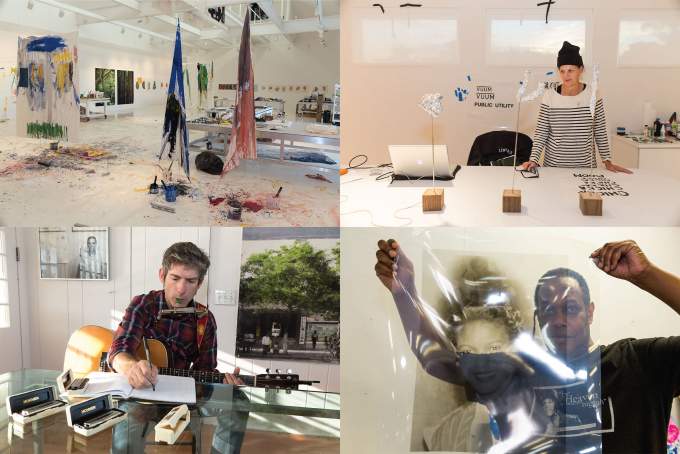
Photos: Sage Sohier
Thirty–Three Days and Nights: Rauschenberg Residency 9
Once the home of the Calusa Indian tribe and then two centuries later, a fishing destination for Theodore Roosevelt and Thomas Edison, Captiva Island, Florida, now boasts luxury homes on a street nicknamed the “Gold Coast.” But the enchantment of the land that Robert Rauschenberg embraced for forty years remains and is invigorated by the newest, and perhaps most itinerant, visitors to the island, the artists in residence at the Rauschenberg Residency. And so what does this small cohort of artists do for thirty-three days on this island in the Gulf of Mexico?
“I was able to work on thirty-five paintings and experiment with different surfaces instead of canvas (muslin, plastic, plexi). I experimented with different forms of hanging, suspending work from the ceiling like stretched cowhide or suspended from a point (this technique also allowed me to consider installation work more effectively than I am usually able to in my studio). The last five paintings at the residency incorporated plastic/drop cloth from the floor and allowed me to begin a dialogue between painting and performance,” wrote Gage Peer (Santa Fe). And did this differ from his original intention? “I did plan to work with painting, but the amount of work and the introduction of these materials and how they would change my painting process was not planned.”
For many, the experience transcends initial aspirations. “I accomplished so much . . . above and beyond my expectations!” wrote Laurie Lambrecht (Bridgehampton, NY), and so, too, for David Francis (Minneapolis), “The pace and depth of work on my memoir was far beyond my expectations that I remain flabbergasted.”
The plan is often best left behind, as Douglas Coupland (Vancouver) noted, “I think that if I arrived with a definite idea in my head and only worked on that idea, it would defeat the spell of the place.” The residency experience has also proven to be a trigger. “When I got home I had a creative explosion that could never have happened if not for the ideas from RR and their incubation there.”
Another artist, Brighde Mullins (Los Angeles), wrote afterward, “To be in a place where nature is still in charge was a huge influence. I felt like I had a different experience of time because of the proximity to the water and the plants and animals. Being on Captiva was a daily lesson in humility and in the finite capacity of humans. Being in Bob’s World was inspiring and calming. I remembered that I used to draw and paint and make collages of my play worlds (I’m primarily a playwright), and being around his work and his spirit reconnected me to the multidimensional aspect of creating a character.”
Collaborations took place slowly and organically. As Keith Sklar (Chicago) listed in his follow-up evaluation: “Experiments with residency staff Matt, Carrell, and Maria in silkscreen. Exploration of digital printing and Photoshop with Carrell and Ehren. An improvised performance with musician David Ornette Cherry and painter Gage Peer. Planned possible series of public artworks in collaboration with Dorit Cypis and Brighde Mullins, based on Brighde’s work on Phyllis Wheatley. Discussions and critiques of a range of residents’ art practices and ideas throughout the residency.”
The community was engaged, as well, through an outreach where the two musicians, David Ornette Cherry (Portland, OR) and Colin Gilmore (Austin) performed for 160 elementary school students at Sanibel School. Later the same day, an Open Studio was held in the Main Studio at the residency for fifty community members.
And there was time for other kinds of work, too, as Dorit Cypis noted. “Resting, listening, biking, dreaming, reflecting, questioning, sharing, communing, exploring, experimenting, recognizing others, recognizing myself, writing, wandering, wondering, walking, boating, beaching, bird watching, eating.”
The influence of Robert Rauschenberg pervades the residency as Mary Ellen Carroll (New York) reflected, “I thanked him constantly as he and his legacy made it possible to be there and to work as an artist. To have the people and equipment and facilities to realize 500 silkscreens and digital prints and paintings. . . .”
“I look forward to the months ahead to absorb and utilize the inspiration and ideas,” Laurie Lambrecht wrote, summing up the residency experience. “I learned much about myself; it was a time of growth.”
